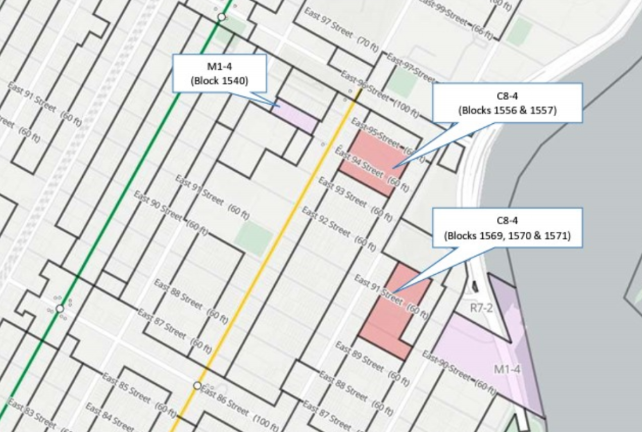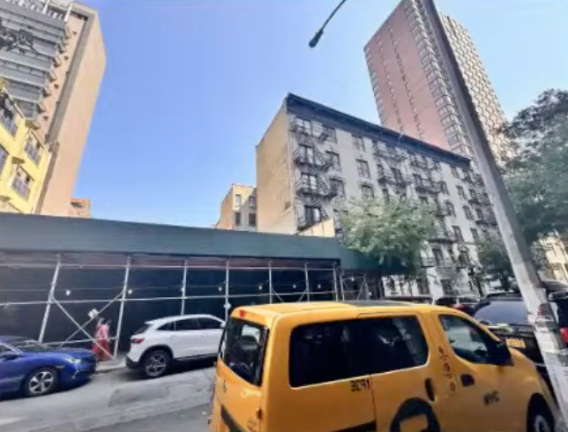CB8 Task Force Proposes Rezoning More Upper East Side Blocks to Residential
Community Board 8’s Task Force for Residential Rezoning continued a mission to advocate for the conversion of outdated manufacturing & commercial zones into residential ones. Iron Horse Labs, a life sciences facility that is currently under construction on E. 94th St., prompted plenty of discussion.
Community Board 8’s Task Force for Residential Rezoning held another meeting on October 17, where they continued to push for the conversion of Upper East Side manufacturing & commercial zones into residential ones. Local communities boards are consulted in rezoning processes that the City Planning Commission and the NY City Council have final say over.
Elisabeth Rose, who co-chairs the task force alongside Adam Wald, began the meeting by explaining the overarching rationale behind the year-old project: “What many of us probably never imagined is that there are parts of Community Board 8–and in particular parts of the Upper East Side–that continue to be zoned for manufacturing or commercial use only. If a property were to be demolished, only commercial or manufacturing uses could be put up on that location. A new residential facility would not be permitted.”
”It is kind of astonishing to think that, in a very residential neighborhood in a city that is in desperate need of housing, that there would still be locations in our community that would not allow for new residential development,” she added.
Rose then outlined a number of parameters that the community board hoped to see taken into consideration. This includes boosting residential development while maintaining current density, meeting affordable Mandatory Inclusionary Housing requirements triggered by 25,000 sq. ft. of floor area, creating contextual zones that take into account height limits, ensuring that zones mirror the character of buildings across the street, and creating “grandfathered” zones that allow existing commercial developments to remain operating.
Future development under in mixed-use “grandfathered” zones would be residential, the co-chairs later elaborated.
Adam Wald then outlined a few streets that the task force had reviewed for this month–the northern side of E. 91st St., the southern side of E. 92nd St., the northern and southern sides of E. 94th St., and the southern side of E. 95th St.
On these blocks, he said, “we have self-storage, we have overbuilt schools in mid-block, we have life-science developments that are being planned, we have underutilized garages in mid-block.” The task force’s goal was not to “discourage” such development, he clarified, but rather to push for the replacement of the blocks’ underlying commercial zones with residential ones.
One project came up again and again, both from community board members and local residents calling into the meeting: Iron Horse Labs, a 200,000 sq. ft life sciences facility currently in the midst of construction at 309 E. 94th St. Overseen by Taconic Partners and named after Lou Gehrig, the baseball player and eponymous “Iron Horse” that the neurodegenerative disease ALS got its name from, the project is anticipated to cost hundreds of millions of dollars by the time it opens sometime in 2025.
”When you add it all up, [Iron Horse Labs] will be over 190 ft. tall. Of course, we’d love to see a 190 ft. residential development here, but that’s not happening,” Wald pointedly said.
Michele Birnbaum, a fellow Community Board 8 member, was curious about whether or not the project was actively being built. “A lot of these projects, if they’re underfunded or if they have any problems, there are fits and starts. They start, they build, then they lay around for a couple of years,” she said.
Wald responded that he had taken a stroll by the premises, and that it appeared to be an active construction site, although he couldn’t be sure since it was the weekend and nobody was working.
Dayna Sessa, who lives on E. 94th St., offered that she believed the construction site was “inactive.” While she was “actually excited about the life sciences building...they’re not necessarily the best of neighbors,” she said, given the scaffolding around the site.
Sessa also expressed polite skepticism that residential conversions would be appropriate if they didn’t end up being somewhat “mixed-use,” or residential buildings with ground floors that are open to the wider public. Noting that she had children, she said that was worried about the “walkability” and “circadian rhythm” of the block.
“That’s a useful suggestion,” task force co-chair Rose replied.

